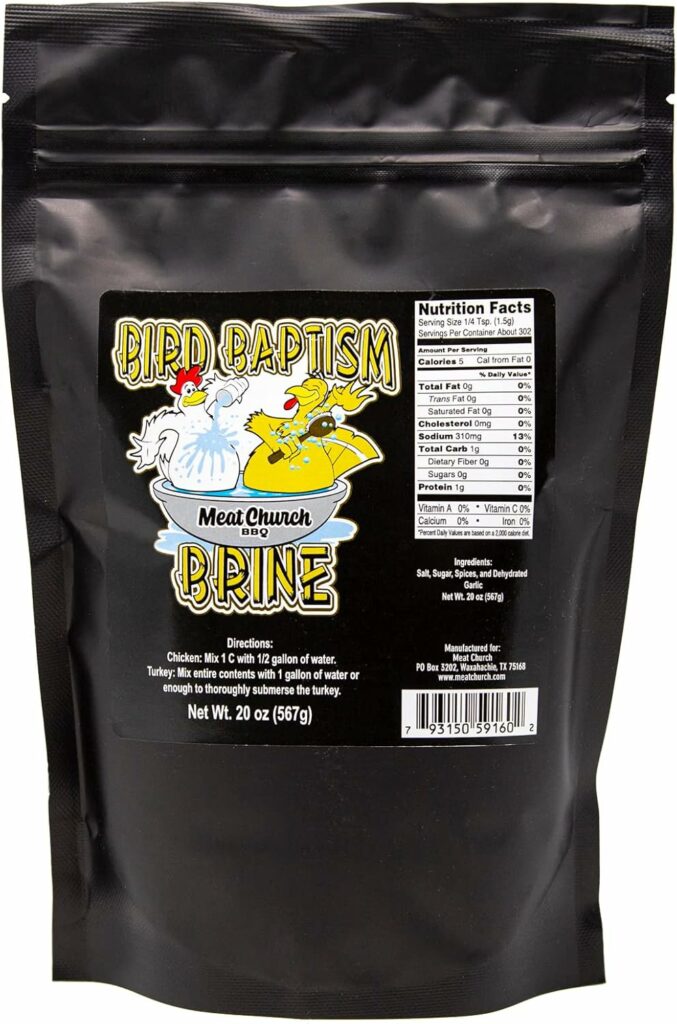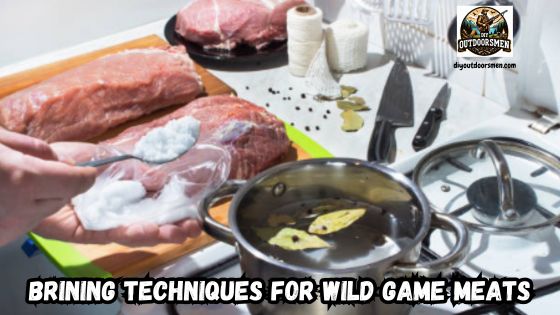Contents
- 1 Why Brine Game Meat?
- 2 Understanding the Two Main Brining Techniques
- 3 Wet Brining Game Meats
- 4 Dry Brining Made Simple
- 5 Tips for Successful Brining with Game Meat
- 6 Common Challenges With Brining Game Meat and How I Deal With Them
- 7 Advanced Tips for Flavor and Texture
- 8 Uses and Real-Life Benefits
- 9 Frequently Asked Questions
- 10 Brining as a Reliable Step for Better Game Cooking
Brining is a reliable way for me to get more flavor, tenderness, and juiciness out of wild game meats. Whether I’m cooking venison, duck, or rabbit, a well-crafted brine can turn a tough or dry cut into something that tastes impressive and feels more familiar for those new to wild flavors.
QUICK LOOK: Tips for Brining Game Meat
- Keep Brine Cold: Brine must always be cool before adding the meat to avoid spoiling. I chill or even freeze part of the water if I’m in a hurry.
- Use Nonreactive Containers: Stainless steel, glass, or heavy plastic prevent unwanted flavors from leaching into the brine and make cleanup easier.
- Make Sure the Meat Stays Submerged: Sometimes I use a plate or clean weight to keep the meat underwater in a wet brine. For flatter cuts, a zip bag works wonders.
- Don’t Overdo It with Aromatics: Strong flavors like cloves, cinnamon, or a lot of rosemary can overpower game. I add extras a little at a time and taste the brine (before adding meat) to check.
- Rest After Brining: Letting the meat rest uncovered in the fridge for an hour or so after brining dries the surface, which gives me better browning and crisper skin.
In this article, I’m going to walk through different brining methods, practical advice, and a few tips I’ve picked up that really help game meats shine. If you’re ready to get into making wild game a delicious experience for everyone at the table, let’s jump into the world of brining.
Why Brine Game Meat?
Game meats like venison, pheasant, or wild boar often have a reputation for being a little stronger in flavor and drier in texture compared to standard beef or chicken. Much of this comes down to lower fat content and a more active lifestyle in the wild.
Brining helps with both of these things. By soaking the meat in a salt-based solution, I can add moisture and mellow out any gamey notes, creating a milder and more tender result. This is especially helpful if I’m introducing someone to game who’s used to classic grocery store cuts.
According to culinary studies, soaking wild game in a saltwater brine changes the muscle fibers, helping them retain more moisture during cooking (North American Whitetail). You might notice how much juicier and easier to eat these cuts become after brining, making your meals more enjoyable all around. For folks who normally shy away from bold, wild flavors, a good brine is a game-changer.
Understanding the Two Main Brining Techniques
There are two methods I use most often: wet brining and dry brining. Both bring solid results, but how I choose between them depends on the type and cut of meat, as well as my schedule. Whether you want to really season a large roast or just amp up a batch of fresh pheasant breasts, picking the right brine makes a big difference.
- Wet Brining: Submerging the meat in a seasoned saltwater solution.
- Dry Brining: Rubbing the meat directly with salt and letting it sit uncovered in the fridge.
Wet Brining Game Meats
Wet brining involves fully immersing a cut of meat in a saltwater bath. I like using this method for whole birds, larger roasts, or when I want to add herbs and spices directly into the mix. For gatherings or game dinners, wet brining is my go-to, since it allows even big cuts to pick up steady moisture and nuanced flavors.
Basic Wet Brine Formula
A general starting point for me is 1 tablespoon of kosher salt per cup of water. For bigger batches, that turns into about 1 cup of salt for every 1 gallon of water. If I want a hint of sweetness or extra flavor, I’ll toss in some brown sugar, cracked pepper, bay leaves, or garlic cloves.
For strong-flavored meats like wild duck or boar, I sometimes use citrus peels or juniper berries for a fresher taste. To give the brine a bit of warmth, I occasionally add a pinch of allspice or coriander seeds, but I always taste the mix before letting the meat soak in it.
How I Wet Brine
- Mix the salt, water, and any flavorings in a large container.
- Stir until everything dissolves fully.
- Let the solution cool completely. I never put raw meat in warm water since that risks spoiling.
- Submerge the game meat, making sure it’s fully covered.
- Cover the container and refrigerate.
Small cuts like rabbit pieces or dove breasts can soak for 3 to 6 hours. Bigger game, like venison roasts or a whole wild turkey, should be brined for 12-24 hours. Over-brining can make meat taste salty or give it a mushy texture, so I keep out a timer or phone reminder whenever I set up a brine. If you want to add even more flavor, try adding a splash of apple cider or a few sprigs of thyme into the brine, but don’t overdo it—subtlety helps the meat shine.
After Wet Brining
I usually remove the meat from the brine, rinse it quickly under cold water to get rid of any extra salt, and then pat it very dry. Letting it air-dry for another hour on a rack in the fridge helps develop a crispier crust or skin when I cook it. This extra step makes a world of difference, especially when you want that golden, crackly finish on roasted birds or a nice seared crust on venison steaks.



Dry Brining Made Simple
Dry brining skips the water. Instead, I rub a generous amount of kosher salt (and sometimes ground spices or sugar) all over the meat, including under the skin if possible. I place it on a rack in the refrigerator, uncovered, to let the salt do its work. This is perfect for steaks, backstraps, or even a whole quail when I’m short on fridge space or want a straightforward, mess-free prep.
How I Dry Brine
- Weigh or estimate the amount of salt (about 1/2 teaspoon per pound of meat is good for me).
- Rub salt and seasonings evenly. Work it into thicker parts, fat caps, or under skin for birds.
- Set the meat on a wire rack over a tray and refrigerate uncovered for 6-24 hours, depending on the cut’s thickness.
During this time, salt draws out moisture, which then gets reabsorbed into the meat, taking all the seasoning with it. Dry brining does not add extra liquid, so the flavor of the game will be more pronounced and natural, but still easier to eat and less dry. If you’re short on time, even an hour of dry brining can make a difference in the overall taste.
After Dry Brining
Pat the meat dry with paper towels before searing, roasting, or grilling. I don’t rinse after a dry brine. If some parts look crusty, extra fat or seasoning rubbed on before cooking helps balance the finish. This method steps up the flavor without extra fuss, and you’ll notice the tenderness as soon as you slice in.
Tips for Successful Brining with Game Meat
- Keep Brine Cold: Brine must always be cool before adding the meat to avoid spoiling. I chill or even freeze part of the water if I’m in a hurry.
- Use Nonreactive Containers: Stainless steel, glass, or heavy plastic prevent unwanted flavors from leaching into the brine and make cleanup easier.
- Make Sure the Meat Stays Submerged: Sometimes I use a plate or clean weight to keep the meat underwater in a wet brine. For flatter cuts, a zip bag works wonders.
- Don’t Overdo It with Aromatics: Strong flavors like cloves, cinnamon, or a lot of rosemary can overpower game. I add extras a little at a time and taste the brine (before adding meat) to check.
- Rest After Brining: Letting the meat rest uncovered in the fridge for an hour or so after brining dries the surface, which gives me better browning and crisper skin.
Common Challenges With Brining Game Meat and How I Deal With Them
- Too Salty: Over-brined meat or too much salt can make the outcome taste unpleasant. I always use measured salt and don’t leave anything in brine for much longer than recommended. Double-checking the time can save your meal.
- Waterlogged Texture: Thin cuts can become mushy with too much time in a wet brine. I use dry brining for small or tender cuts instead; it’s a great way to keep texture in check.
- Lack of Flavor Penetration: Large roasts or bone-in pieces sometimes need more time or a few needlelike pokes to help the brine get in deeper. Using a marinade injector can also help.
- Fridge Space: I sometimes have trouble fitting containers in my fridge. Gallon zip baggies squeezed flat save space and make sure the meat is still fully surrounded by liquid. For bigger projects, brining coolers with ice packs works too.
Advanced Tips for Flavor and Texture
After trying both main methods, I sometimes like to get a little creative:
- Use Buttermilk for Brining: For upland birds or rabbit, a buttermilk marinade with salt can mellow flavors and keep white meats moist. The acidity also tenderizes the meat gently and gives the surface a nice color after cooking.
- Add Sweet and Savory Elements: Brown sugar, maple syrup, or fruit juice added to a brine can help balance out strong wild meat flavors. For a special twist, try a bit of honey or even pomegranate juice for a unique finish.
- Experiment With Brining Times: For meats like wild boar or older venison, a brine on the longer side can soften resilient fibers. For very tender cuts (like small grouse), shorter times are better. Keeping notes on your results helps refine your approach over time.
- Combine Brine With Marinades: I often brine game first to improve moisture, rinse, pat dry, then marinate in herbs, spices, and oils for custom flavors before grilling or roasting. This “one-two punch” approach brings both juiciness and next-level cool flavor to your table.
Uses and Real-Life Benefits
Brining helps me get consistent results, even with unpredictable cuts of wild meat. Whether I’m looking to make pulled goose sandwiches, chili from venison, or a simple roast pheasant, brining helps keep the final dish moist and tender.
Game cooked without brining is much more likely to dry out or taste overpoweringly wild. Serving wild food prepared this way encourages even picky eaters to try new dishes and enjoy wild harvests, boosting the appeal of eating what you bring home from the woods.
- Venison Roasts: After a 24-hour wet brine, serve with berry sauce for a flavorful yet classic dish.
- Duck Breasts: A short dry brine and crisp sear make them taste more like restaurant duck than something from the marsh. Even folks who usually skip wild duck will come back for seconds.
- Rabbit or Squirrel Stews: Wet brining before stewing prevents the meat from getting stringy or chalky, giving the finished dish a smoother bite.
- Wild Turkey Breast: Dry brining ensures even thin slices stay juicy for sandwiches or salads, perfect for leftovers or meal-prep lunches.
Frequently Asked Questions
Here are some questions I hear from friends or see online whenever the topic of brining game meats comes up. Jump in if you have more or want tips on different game species:
Do I have to rinse meat after brining?
I usually rinse after a wet brine to remove extra salt. After a dry brine, I just pat dry. Always taste your brine before adding meat to check saltiness.
What is the difference between a marinade and a brine?
A marinade is oil or acid-based and focuses mainly on the outer flavors, while a brine’s salt draws moisture into the meat fibers for a more thorough effect.
Can I reuse brine?
I do not reuse any brine that has had raw meat in it for food safety reasons.
Brining as a Reliable Step for Better Game Cooking
Adding brining to my wild game prep has changed how I cook and serve these meats. With just a few simple choices between wet or dry methods, and a little planning, I can guarantee my dishes are juicy, flavorful, and always enjoyable, even for folks who don’t usually eat wild game.
If you haven’t tried brining your own harvest yet, it’s worth giving it a shot; you might find even old hunting favorites get tastier and more approachable at your table. Take up brining, and let your wild flavors win over the whole crowd.
Most Recent Articles:
- Complete Guide On Tracking Game Animals

- DIY 4-Step Guide To Field Dressing And Quartering A Deer

- Night Vision Binoculars For Nocturnal Hunting

- The Science Behind Camouflage Patterns For Deer Hunting

- Binocular Accessories For Hunters

- 9 Tips for Using Trail Cameras To Track Deer Movements

As always, stay safe, enjoy the journey, and please try to leave it cleaner than you found it. If you have any comments, questions, ideas, or suggestions, please leave them in the comment section below, and I’ll get back to you ASAP. You can follow us on YouTube: Man Art Creations for videos of our DIY Adventures.
P.S. Thanks so much for checking out our blog; we really appreciate it. Just so you know, we may receive a commission if you click on some of the links that appear on our site. This helps us keep our content free and up-to-date for everyone. We appreciate your support!



